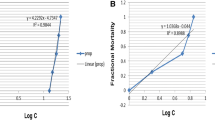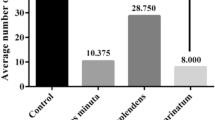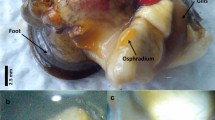Abstract
This present study was aimed at assessing the toxicological effects of the leaf extracts of Picralima nitida on aspects of the biology of Lanistes varicus. The extraction of the leaf, biochemical parameters and toxicity tests were performed using standard methods.. Acetylcholinesterase’s activity was mostly inhibited in the snail’s intestine and haemolymph by the aqueous extract and in the hepatopancreas by ethanol extract. The total protein level of the snail was mostly decreased in the haemolymph by the ethanol extract while in the hepatopancreas, it was mainly decreased by the aqueous extract. There was decrease in the total protein levels of muscle, haemolymph, hepatopancreas and intestine in comparison with the control groups. There were significant (p < 0.05) decreases in the acid phosphatase activity in all the tissues, especially hepatopancreas, intestine and muscle, of the treated groups, compared to the control. Significant (p < 0.05) decreases were observed in the alkaline phosphatase activity in the haemolymph, hepatopancreas and intestine of all the treated groups. Exposure to increasing concentrations of the extracts, especially the ethanol extract, brought about induction of production of male sex hormone in snails. The study provides a scientific basis for exploiting local and indigenous plant resources in Nigeria for the control of freshwater snails and trematode borne infections.


Similar content being viewed by others
Data availability
The datasets used and/or analysed during the current study are available from the corresponding author on reasonable request.
References
Abdullahi Y, Muhammad I, Yerima MI (2018) Molluscicidal activity of aqueous extract of leaves, stem back and roots of Desert date (Balanite egyptiaca Del.) against common liver fluke (Fasciola hepatica) found in the snail (Lymnea natalensis). J Appl Sci Environ Manage 22(3):409–413. https://doi.org/10.4314/jasem.v22i3.21
Akinpelu BA, Dare CA, Adebesin FI, Iwalewa EO, Oyedapo OO (2012) Effects of stem-bark of Erythrophleum suaveolens (Guill. and Perri.) saponin on freshwater snail (Lanistes lybicus) tissues. AJEST 6(11):446–451. https://doi.org/10.5897/AJEST12.007
Awharitoma AO, Ehigiator FAR (2012) Parasitic infection in the freshwater snails, Pila ovata and Lanistes varicus (Gastropoda: Ampullariidae). NISEB J 12(1):15–20
Botham KM, Mayes PA (2003) Bioenergetics: The role of ATP. In: Botham KM, Mayes PA (eds) Harper’s illustrated biochemistry, 26th edn. McGraw-Hill, New York, pp 80–85
Ellman GL, Courtney KD, Andres V, Featherstone RM (1961) A new and rapid colorimetricdetermination of acetylcholinesterase activity. Biochem Pharmacol 7(2):88–95. https://doi.org/10.1016/0006-2952(61)90145-9
Eze JC, Okafor F, Nwankwo NE, Okeke ES, Onwudiwe NN (2020) Schistosomiasis prevention option: toxicological evaluation of Vernonia amygdalina on the tissues of Bulinus truncatus at different pH conditions. Heliyon 6:e04796. https://doi.org/10.1016/j.heliyon.2020.e04796
Finney DJ (1971) Probit analysis. Cambridge University Press, Cambridge
Gupta V, Rao G (1974) Histochemical studies on the choroid plexus of the goat embryos. Histochemical distribution of acid and alkaline phosphatases. Acta Trop 499:60–63
Jamshidi-Kia F, Lorigooini Z, Amini-Khoei H (2018) Medicinal plants: Past history and future perspective. J Herbmed Pharmacol 7(1):1–7. https://doi.org/10.15171/jhp.2018.01
Lodish H, Berk A, Zipursky SL, Matsudaira P, Baltimore D, Darnell J (2000) Organelles of the eukaryotic cell. In: Lodish H, Berk A, Zipursky SL, Matsudaira P, Baltimore D, Darnell J (eds) Molecular and Cell Biology, 4th edn. WH Freeman, New York, pp 730–745
Mandefro B, Mereta ST, Tariku Y, Ambelu A (2017) Molluscicidal effect of Achyranthes aspera L. (Amaranthaceae) aqueous extract on adult snails of Biomphalaria pfeifferi and Lymnaea natalensis. Infect Dis Poverty 6:133. https://doi.org/10.1186/s40249-017-0349-4
Massoud AM, Habib FS (2003) The effects of Myrrh (Commiphora molmol) on infected snails of Schistosoma spp. and their egg masses: Effect on shedding of cercariae and on snail fecundity. J Egypt Soc Parasitol 33(2):585–596
McManus DP, Dunne DW, Sacko M, Utzinger J, Vennervald BJ, Zhou XN (2018) Schistosomiasis. Nat Rev Dis Primers 2018(4):13. https://doi.org/10.1038/s41572-018-0013-8
Mearns AJ, Bissell M, Morrison AM, Rempel-Hester MA, Arthur C, Rutherford N (2019) Effects of pollution on marine organisms. Water Environ Res 91(10):1229–1252. https://doi.org/10.1002/wer.1218
Nelwan ML (2019) Schistosomiasis: Life cycle, diagnosis, and control. Curr Ther Res 91:5–9. https://doi.org/10.1016/j.curtheres.2019.06.001
Otoo LF, George AK, Ansah C, Mensah BK, Benneh CC (2015) Assessment of an ethanolic seed extract of Picralima nitida ([Stapf.] Th. and H. Durand) on reproductive hormones and its safety for use. J Intercult Ethnopharmacol 4(4):293–301. https://doi.org/10.5455/jice.20151030085004
Oyedapo OO (1996) Studies on bioactivity of the root extract of Plumbago zeylanica. Int J Pharmacogen 34:365–369. https://doi.org/10.1076/phbi.34.5.365.13249
Pichit W, Thapana C, Watchariya P (2021) Cercarial trematodes in freshwater snails from Bangkok, Thailand: Prevalence, morphological and molecular studies, and human parasite perspective. Parasitol 148(3):366–383. https://doi.org/10.1017/S0031182020002073
Sanni MS, Van-Etten RL (1978) An essential carboxylic acid group in human prostrate acid phosphatase. Biochem Biophysiol Acta 568:370–376. https://doi.org/10.1016/0005-2744(79)90305-x
Sanu KM, Istifanus WA, Musa MS, Mao PS (2020) The diversity of fresh water snail fauna in Kiri dam, Adamawa State, North Eastern Nigeria. GSC Biol Pharm Sci 11(02):099–104. https://doi.org/10.30574/gscbps.2020.11.2.0118
Sarieh S, Javad SR, Farzaneh MR, Mohammad RS, Mohammad RA (2014) Effects of aqueous root extracts of Anacyclus pyrethrum on gonadotropins and testosterone serum in adult male rats. AJPCT 2(6):767–772
Sharma V, Boonen J, Spiegleer BD, Dixit VK (2013) Androgenic and spermatogenic activity of alkylamide-rich ethanol solution extract of Anacyclus pyrethrum. Phytother Res 27(1):99–106. https://doi.org/10.1002/ptr.4697
Singh SK, Singh A (2003) Molluscicidal and anticholinesterase activity of Alstoniascholaris plant against fresh water snail Lymnaea acuminata. PJBS 6:1442–1446. https://doi.org/10.3923/pjbs.2003.1442.1446
Sripa B, Kaewkes S, Intapan PM, Maleewong W, Brindley PJ (2010) Food-bornetrematodiases in Southeast Asia: epidemiology, pathology, clinical manifestation and control. J Adv Parasitol 72:305–350. https://doi.org/10.1016/S0065-308X(10)72011-X
Wang W, Mao Q, Yao J, Yang W, Zhang Q, Lu W, Deng Z, Duan L (2018) Discovery of the pyridylphenylureas as novel molluscicides against the invasive snail Biomphalaria straminea, intermediate host of Schistosoma mansoni. Parasit Vectors 11:291. https://doi.org/10.1186/s13071-018-2868-7
World Health Organization (WHO) (1985) Control of foodborne trematode infections. Report of a WHO study group. World Health Organ Tech Rep Ser 849:1–157
Acknowledgements
We sincerely wish to acknowledge all the staff members of the Department of Zoology and Environmental Biology both academic and non-academic, University of Nigeria, Nsukka, for their assistance during the period of this study.
Funding
The research did not receive funding from any organization or institution.
Author information
Authors and Affiliations
Contributions
CUA carried out the laboratory study of the research. ALE helped in the designing and supervision of the research. JCE helped out in the laboratory experiments and also statistically analyzed the data. NEN helped out in designing the work and wrote the manuscript for publication. FCO supervised and contributed financially to the execution of the project.
Corresponding author
Ethics declarations
Ethics approval and consent to participate
Clearance for humane handling of experimental animals and for conducive experimental conditions for laboratory practice was given by the ethical committee of the Department of Zoology and Environmental Biology, University of Nigeria Nsukka.
Competing interests
The authors declare no competing interests.
Additional information
Publisher's note
Springer Nature remains neutral with regard to jurisdictional claims in published maps and institutional affiliations.
Rights and permissions
About this article
Cite this article
Abonyi, C.U., Ezugwu, A.L., Eze, J.C. et al. Toxicological impact of Picralima nitida (pile plant) extracts on the gastropod Lanistes varicus (freshwater snail), as a control measure against trematodes infections. Biologia 77, 2093–2101 (2022). https://doi.org/10.1007/s11756-022-01075-x
Received:
Accepted:
Published:
Issue Date:
DOI: https://doi.org/10.1007/s11756-022-01075-x




